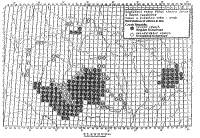 |
Last Update:
Friday November 23, 2018
|
| [Home] |
|
Volume 8 Pages 1 - 47 (February 1993) Citation: Hlaváč, V. & Toman, A. (1993) Otter Distribution and Conservation in the Czech Republic. IUCN Otter Spec. Group Bull. 8: 36 - 37 Otter Distribution and Conservation in the Czech Republic Václav Hlaváč1 and Aleš Toman2 1ČUOP.
Havličkův Brod, Ledečska
2136, Czech Republic
PRESENT STATUS The otter has been protected since 1949 and appears on the Czech Red List of Endangered Species (Baruš et al, 1989). Since 1988 the Czech Institute for Nature Conservation (ČUOP) has been active in otter research and protection. In the last four years members from ČUOP yearly organized a monitoring programme using more than 150 fieldworkers to survey for otter signs in the fresh snow. Based on these results we presume that there are approximately 300-350 otters left in the Czech Republic. Their distribution is shown in Figure 1 (Toman 1992).
At present there are three isolated populations. The north Bohemian population is linked with the population in former East Germany. The population in north-east Moravia is linked with the Slovak and Polish populations. South Bohemia harbours the strongest population of the Czech Republic. Otters there used three different habitats, mountain with oligotrophic streams, South Bohemian fishpond area, and highland area with small streams and ponds. This population makes up about 85 % of the total Czech population. The South-Bohemian population is linked with the remaining populations in the Bavarian forest and Austria. CONSERVATION ACTIVITIES In 1988, ČUOP started the "Otter Conservation Programme" for the Czech Republic (Hlaváč, 1991). This programme focuses on three different approaches. 1. Field Research To continue research on distribution, ecology and diet of the otter, water pollution, habitat destruction, etc. In the last two years twelve dead otters were analysed for PCBs. Contents ranged from 19-260 mg/kg of fat, the main being 112 mg/kg (Hlaváč & Toman, 1991). These data are cause for serious concern. Research on PCS pollution will continue through analysing food, spraints and dead otters in several different habitats to examine the flow of pollution through the foodchain. 2. Breeding and Reintroduction Programme In 1990 a research and breeding station was founded in Pavlov near Havličkův Brod. Here otters are kept for breeding and fundamental research. At present there are three wild-found otters. This spring construction will be finished. By than the station will comprise six big enclosures and a quarantine enclosure. Together with the Dutch Otterstation Foundation, ČUOP has a joint breeding and reintroduction programme. For this a limited number of otters from the South-Bohemian population will be caught over a number of years. Additional otters will be obtained through the programme for care of injured otters at the Otterstation and through exchange with other otter-breeding stations. In the area between the existing populations the otter became extinct owing to hunting. At present this area still has large regions with good otter habitat. However, natural migration from the present populations is impossible or does not occur. It is now debated whether repopulation of these empty niches should occur solely through natural migration or that the South-Bohemian and Moravian populations should be linked through reintroduction. The possibilities for improving natural migration from South Bohemia north-eastward will be investigated. 3. Restoration of otter habitat This is a relatively new problem for the nature conservationists in our country. There are many canalized streams and now a big government project for revitalisation has begun. In 1992 revitalisation of the first two streams has started. The aspect of isolation of otter habitat and dissection of home ranges through improvements of roads will receive attention through a pilot study. REFERENCES Baruš, V. et al (1989). Červená
kniha, (Red book) Vol II. SZN Praha. |
| [Copyright © 2006 - 2050 IUCN/SSC OSG] | [Home] | [Contact Us] |
